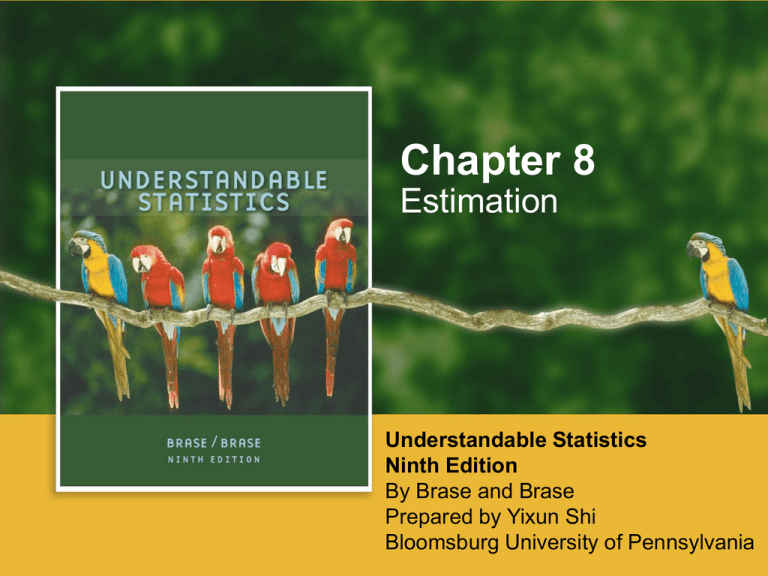
Chapter 8
Estimation
Understandable Statistics
Ninth Edition
By Brase and Brase
Prepared by Yixun Shi
Bloomsburg University of Pennsylvania
Estimating µ When σ is Known
Copyright © Houghton Mifflin Harcourt Publishing Company. All rights reserved.
8|2
Point Estimate
• An estimate of a population parameter given by
a single number.
Copyright © Houghton Mifflin Harcourt Publishing Company. All rights reserved.
8|3
Margin of Error
• Even if we take a very large sample size,
will differ from µ.
x
Margin of Error x
Copyright © Houghton Mifflin Harcourt Publishing Company. All rights reserved.
8|4
Confidence Levels
• A confidence level, c,
is any value between
0 and 1 that
corresponds to the
area under the
standard normal
curve between –zc
and +zc.
Copyright © Houghton Mifflin Harcourt Publishing Company. All rights reserved.
8|5
Critical Values
Copyright © Houghton Mifflin Harcourt Publishing Company. All rights reserved.
8|6
Common Confidence Levels
Copyright © Houghton Mifflin Harcourt Publishing Company. All rights reserved.
8|7
Recall From Sampling Distributions
• If we take samples of size n from our
population, then the distribution of the sample
mean has the following characteristics:
Mean of x x x
Standard Deviationof x x x
Copyright © Houghton Mifflin Harcourt Publishing Company. All rights reserved.
n
8|8
Copyright © Houghton Mifflin Harcourt Publishing Company. All rights reserved.
8|9
A Probability Statement
• In words, c is the probability that the sample
mean will differ from the population mean by at
most
Copyright © Houghton Mifflin Harcourt Publishing Company. All rights reserved.
8 | 10
Maximal Margin of Error
• Since µ is unknown, the margin of error | x - µ|
is unknown.
• Using confidence level c, we can say that
differs from µ by at most:
Copyright © Houghton Mifflin Harcourt Publishing Company. All rights reserved.
x
8 | 11
Confidence Intervals
Copyright © Houghton Mifflin Harcourt Publishing Company. All rights reserved.
8 | 12
Copyright © Houghton Mifflin Harcourt Publishing Company. All rights reserved.
8 | 13
Critical Thinking
• Since x is a random variable, so are the
endpoints x E
• After the confidence interval is numerically fixed
for a specific sample, it either does or does not
contain µ.
Copyright © Houghton Mifflin Harcourt Publishing Company. All rights reserved.
8 | 14
Critical Thinking
• If we repeated the confidence interval process
by taking multiple random samples of equal size,
some intervals would capture µ and some would
not!
• Equation
states that the
proportion of all intervals containing µ will be c.
Copyright © Houghton Mifflin Harcourt Publishing Company. All rights reserved.
8 | 15
Multiple Confidence Intervals
Copyright © Houghton Mifflin Harcourt Publishing Company. All rights reserved.
8 | 16
Estimating µ When σ is Unknown
• In most cases, researchers will have to estimate
σ with s (the standard deviation of the sample).
• The sampling distribution for x will follow a
new distribution, the Student’s t distribution.
Copyright © Houghton Mifflin Harcourt Publishing Company. All rights reserved.
8 | 17
The t Distribution
Copyright © Houghton Mifflin Harcourt Publishing Company. All rights reserved.
8 | 18
The t Distribution
Copyright © Houghton Mifflin Harcourt Publishing Company. All rights reserved.
8 | 19
The t Distribution
• Use Table 6 of
Appendix II to find the
critical values tc for a
confidence level c.
• The figure to the right
is a comparison of
two t distributions and
the standard normal
distribution.
Copyright © Houghton Mifflin Harcourt Publishing Company. All rights reserved.
8 | 20
Using Table 6 to Find Critical Values
• Degrees of freedom, df, are the row headings.
• Confidence levels, c, are the column headings.
Copyright © Houghton Mifflin Harcourt Publishing Company. All rights reserved.
8 | 21
Maximal Margin of Error
• If we are using the t distribution:
Copyright © Houghton Mifflin Harcourt Publishing Company. All rights reserved.
8 | 22
Copyright © Houghton Mifflin Harcourt Publishing Company. All rights reserved.
8 | 23
What Distribution Should We Use?
Copyright © Houghton Mifflin Harcourt Publishing Company. All rights reserved.
8 | 24
Estimating p in the Binomial Distribution
• We will use large-sample methods in which the
sample size, n, is fixed.
• We assume the normal curve is a good
approximation to the binomial distribution if both
np > 5 and nq = n(1-p) > 5.
Copyright © Houghton Mifflin Harcourt Publishing Company. All rights reserved.
8 | 25
Point Estimates in the Binomial Case
Copyright © Houghton Mifflin Harcourt Publishing Company. All rights reserved.
8 | 26
Margin of Error
• The magnitude of the difference between the
actual value of p and its estimate pˆ is the
margin of error.
Copyright © Houghton Mifflin Harcourt Publishing Company. All rights reserved.
8 | 27
The Distribution of pˆ
• The distribution is well approximated by a
normal distribution.
Copyright © Houghton Mifflin Harcourt Publishing Company. All rights reserved.
8 | 28
A Probability Statement
With confidence level c, as before.
Copyright © Houghton Mifflin Harcourt Publishing Company. All rights reserved.
8 | 29
Copyright © Houghton Mifflin Harcourt Publishing Company. All rights reserved.
8 | 30
Public Opinion Polls
Copyright © Houghton Mifflin Harcourt Publishing Company. All rights reserved.
8 | 31
Choosing Sample Sizes
• When designing statistical studies, it is good
practice to decide in advance:
– The confidence level
– The maximal margin of error
• Then, we can calculate the required minimum
sample size to meet these goals.
Copyright © Houghton Mifflin Harcourt Publishing Company. All rights reserved.
8 | 32
Sample Size for Estimating μ
• If σ is unknown, use σ from a previous study or
conduct a pilot study to obtain s.
Always round n up to the next integer!!
Copyright © Houghton Mifflin Harcourt Publishing Company. All rights reserved.
8 | 33
Sample Size for Estimating pˆ
If we have no preliminary estimate for p, use the following modification:
Copyright © Houghton Mifflin Harcourt Publishing Company. All rights reserved.
8 | 34
Independent Samples
• Two samples are independent if sample data
drawn from one population is completely
unrelated to the selection of a sample from the
other population.
– Occurs when we draw two random samples
Copyright © Houghton Mifflin Harcourt Publishing Company. All rights reserved.
8 | 35
Dependent Samples
• Two samples are dependent if each data value
in one sample can be paired with a
corresponding value in the other sample.
– Occur naturally when taking the same
measurement twice on one observation
• Example: your weight before and after
the holiday season.
Copyright © Houghton Mifflin Harcourt Publishing Company. All rights reserved.
8 | 36
Confidence Intervals for
μ1 – μ2 when σ1, σ2 known
Copyright © Houghton Mifflin Harcourt Publishing Company. All rights reserved.
8 | 37
Confidence Intervals for
μ1 – μ2 when σ1, σ2 known
Copyright © Houghton Mifflin Harcourt Publishing Company. All rights reserved.
8 | 38
Copyright © Houghton Mifflin Harcourt Publishing Company. All rights reserved.
8 | 39
Confidence Intervals for
μ1 – μ2 when σ1, σ2 unknown
• If σ1, σ2 are unknown, we use the t distribution
(just like the one-sample problem).
Copyright © Houghton Mifflin Harcourt Publishing Company. All rights reserved.
8 | 40
Copyright © Houghton Mifflin Harcourt Publishing Company. All rights reserved.
8 | 41
What if σ1 = σ2 ?
• If the sample standard deviations s1 and s2 are
sufficiently close, then it may be safe to assume
that σ1 = σ2.
– Use a pooled standard deviation.
– See Section 8.4, problem 27.
Copyright © Houghton Mifflin Harcourt Publishing Company. All rights reserved.
8 | 42
Copyright © Houghton Mifflin Harcourt Publishing Company. All rights reserved.
8 | 43
Summarizing Intervals for
Differences in Population Means
Copyright © Houghton Mifflin Harcourt Publishing Company. All rights reserved.
8 | 44
Estimating the Difference in Proportions
• We consider two independent binomial
distributions.
• For distribution 1 and distribution 2,
respectively, we have:
n1
p1
q1
r1
n2
p2
q2
r2
• We assume that all the following are greater
than 5:
Copyright © Houghton Mifflin Harcourt Publishing Company. All rights reserved.
8 | 45
Estimating the Difference in Proportions
r1 r 2
Then has the following properties :
n1 n 2
Copyright © Houghton Mifflin Harcourt Publishing Company. All rights reserved.
8 | 46
Copyright © Houghton Mifflin Harcourt Publishing Company. All rights reserved.
8 | 47
Critical Thinking
Copyright © Houghton Mifflin Harcourt Publishing Company. All rights reserved.
8 | 48








